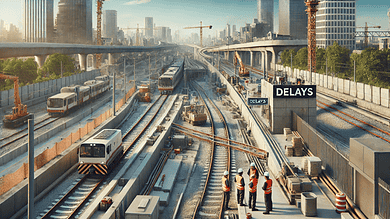Light Rail Risk Assessment Expert: Risk Analysis Strategies

Best Practices in Light Rail Risk Assessment
Effective risk assessment is crucial for the success of light rail projects, ensuring that potential challenges are identified and addressed before they escalate.
Light rail systems are integral to urban transportation, offering an efficient and environmentally friendly mode of transit. However, these projects come with inherent risks that need careful management.
This article explores expert strategies for assessing and mitigating risks in light rail projects, emphasizing the role of light rail risk assessment experts and other key contributors. We will delve into various aspects of risk identification, mitigation strategies, and the importance of expert involvement in managing project risks.
Identifying and Assessing Risks
Types of Risks in Light Rail Projects
Light rail projects face various risks that can impact their success. These risks can be broadly categorized into technical, operational, financial, and environmental. Technical risks involve issues related to engineering, construction, and technology integration.
Operational risks encompass challenges in project execution, maintenance, and day-to-day operations.
Financial risks pertain to budget overruns, funding shortfalls, and economic fluctuations.
Environmental risks include impacts on the surrounding environment, regulatory compliance, and community opposition.
Methods for Identifying Potential Risks
Identifying potential risks requires a systematic approach, including site analysis, historical data review, and stakeholder interviews. Site analysis involves evaluating the physical conditions of the project location, identifying potential hazards, and assessing site-specific challenges. This process includes surveying the area for geological stability, proximity to other infrastructure, and environmental concerns that could impact the project.
Historical data review provides insights into past project issues, helping to anticipate similar problems in the current project. Experts can identify recurring issues and trends by examining previous incidents, maintenance records, and project reports. This data helps forecast potential risks and plan preventive measures.
Stakeholder interviews gather perspectives from various parties involved in the project, highlighting potential concerns and areas of risk. These interviews include discussions with engineers, operators, residents, and government officials. Each stakeholder offers unique insights that contribute to a comprehensive risk assessment.
A Light Rail Risk Assessment Expert uses these methods to develop a thorough understanding of potential risks. Site analysis allows for identifying physical hazards, such as poor soil conditions or nearby construction activities.
Historical data review uncovers patterns of issues that have previously affected similar projects. Stakeholder interviews ensure that all potential risks are considered from multiple viewpoints, including those of engineers, operators, and residents.
Tools and Techniques for Assessing Risk Severity and Probability
Several tools and techniques are employed to assess the severity and probability of identified risks. These include risk matrices, failure mode, effects analysis (FMEA), and quantitative risk assessment (QRA).
Risk matrices visually represent risk levels and help prioritize risks based on their impact and likelihood. This tool allows project managers to identify which risks require immediate attention and resources quickly.
Failure mode effects analysis (FMEA) involves a detailed examination of potential failure modes and their effects, identifying critical areas that require attention. This method helps understand the potential points of failure within the system and their likely impacts, allowing for targeted mitigation efforts.
Quantitative risk assessment (QRA) uses statistical methods to quantify risks, providing a numerical basis for decision-making. QRA offers a detailed numerical analysis of risks, which supports informed decision-making regarding risk management strategies.
A Light Rail Risk Assessment Expert utilizes these tools to evaluate and prioritize risks systematically. Risk matrices provide a clear visual representation of which risks need immediate attention. FMEA helps understand the potential points of failure within the system and their likely impacts. QRA offers a detailed numerical analysis of risks, which supports informed decision-making regarding risk management strategies.

Risk Mitigation Strategies
Once risks are identified and assessed, the next step is to develop strategies to mitigate these risks. Mitigation strategies include engineering solutions, operational changes, and administrative controls.
Engineering solutions might involve redesigning aspects of the light rail system to eliminate or reduce hazards. This could include enhancing structural components, improving signaling systems, or integrating advanced safety technologies.
Operational changes could include altering schedules or routes to avoid high-risk areas, rerouting trains during peak traffic hours to minimize congestion-related risks, or adjusting maintenance schedules to ensure optimal rail system performance.
Administrative controls involve policies and procedures that ensure all personnel are aware of and adhere to safety protocols. This includes comprehensive training programs, regular safety drills, and clear communication channels for reporting and addressing safety concerns.
A Light Rail Risk Assessment Expert designs and implements these strategies to minimize the impact of identified risks. Engineering solutions often involve significant upfront costs but provide long-term safety benefits. Operational changes are typically easier to implement and can be adjusted as needed. Administrative controls ensure that safety measures are consistently applied and monitored.
The Role of Risk and Hazard Analysis
Risk and hazard analysis is a critical component of the risk management process. This involves a detailed examination of potential hazards and their associated risks. Hazard analysis identifies potential sources of harm, while risk analysis evaluates the likelihood and impact of these hazards. Together, these analyses provide a comprehensive understanding of the risk landscape.
A Light Rail Risk Assessment Expert conducts thorough risk and hazard analyses to identify and address all potential issues. This process involves a combination of qualitative and quantitative methods, including expert judgment, statistical analysis, and scenario planning. The goal is to develop a robust risk profile that informs all aspects of project planning and execution.
Continuous Monitoring and Review
Risk management is not a one-time activity but an ongoing process. Continuous monitoring and review are essential to ensure that risk mitigation strategies remain effective. This involves regular inspections, audits, and feedback loops that allow for adjusting risk management plans as necessary.
A Light Rail Risk Assessment Expert establishes processes for continuous monitoring and review. Regular inspections help identify new risks or changes in existing risks. Audits ensure all risk management activities comply with regulatory requirements and best practices. Feedback loops provide valuable insights from project stakeholders, enabling continuous improvement of risk management strategies.
Regular inspections help identify new risks or changes in existing risks. Audits ensure all risk management activities comply with regulatory requirements and best practices. Feedback loops provide valuable insights from project stakeholders, enabling continuous improvement of risk management strategies.
Case Studies Highlighting Risk Identification in Light Rail Projects
These case studies draw on elements that are seen in real cases, but they remain entirely speculative and are used for educational and illustrative purposes.
Case studies of light rail projects can provide valuable insights into the risk identification process. For example, a project in San Francisco identified significant geological risks due to the region’s seismic activity. By conducting thorough site analysis and leveraging historical data, the project team was able to develop strategies to mitigate these risks, ensuring the safety and stability of the rail system.

Mitigation Strategies
Development of Risk Mitigation Plans
Developing effective risk mitigation plans is essential for addressing identified risks. These plans outline specific actions to reduce the likelihood and impact of risks. A risk mitigation plan’s key elements include risk avoidance, transfer, risk reduction, and risk acceptance.
Risk avoidance involves altering project plans to eliminate potential risks. Risk transfer shifts the risk to another party, such as through insurance. Risk reduction focuses on implementing measures to minimize risk impact. Risk acceptance acknowledges the risk but involves monitoring it closely.
Techniques for Minimizing Technical and Operational Risks
Technical and operational risks can be minimized through various techniques, such as adopting advanced engineering solutions, implementing robust quality control processes, and utilizing proven technologies. Regular maintenance schedules, effective project management practices, and contingency planning are critical in mitigating operational risks.
Financial Risk Management Strategies
Financial risks can be managed by securing diverse funding sources, maintaining financial reserves, and conducting regular financial audits. Developing detailed budget forecasts and implementing cost-control measures are essential for preventing budget overruns and ensuring financial stability.
Environmental Risk Mitigation Approaches
Environmental risks require strategies such as conducting environmental impact assessments, adhering to regulatory requirements, and engaging with the community. Implementing sustainable construction practices, using environmentally friendly materials, and monitoring environmental impacts throughout the project lifecycle are crucial for mitigating environmental risks.
Examples of Successful Risk Mitigation in Light Rail Projects
Successful light rail projects provide examples of effective risk mitigation. For instance, a project in Denver implemented advanced monitoring systems to detect and address technical issues promptly. Another project in Portland adopted sustainable construction practices, significantly reducing its environmental footprint and gaining community support.

Role of Risk Assessment Experts
Responsibilities of a Light Rail Risk Assessment Expert
A light rail risk assessment expert identifies, evaluates, and mitigates risks throughout the project lifecycle. Their duties include conducting risk assessments, developing mitigation strategies, monitoring risk factors, and guiding project teams. These experts bring specialized knowledge and experience to ensure comprehensive risk management.
Importance of Rail Project Consulting in Effective Risk Management
Rail project consulting plays a vital role in effective risk management. Consultants provide external perspectives, identify potential blind spots, and offer expertise in rail project management. Their involvement ensures that risk assessment and mitigation are conducted thoroughly and objectively.
How a Rail Transportation Injury Expert Contributes to Safety Assessments
A rail transportation injury expert focuses on assessing and mitigating safety incidents and injuries risks. Their expertise helps identify potential hazards, develop safety protocols, and implement measures to prevent accidents. Their contributions are critical in ensuring the safety of passengers and workers.
Case Studies Showcasing Expert Contributions to Risk Assessment and Mitigation
Case studies highlight the contributions of risk assessment experts in light rail projects. In a project in Seattle, a risk assessment expert identified potential technical risks associated with an innovative rail technology. Their recommendations led to design modifications that enhanced the project’s safety and reliability. In another project in Boston, a rail transportation injury expert developed comprehensive safety protocols that significantly reduced the incidence of worker injuries.

Best Practices in Risk Management
Integrating Risk Management into Light Rail Project Management
Integrating risk management into light rail project management involves incorporating risk assessment and mitigation into all project phases. This includes planning, design, construction, and operations. Proactive risk management ensures that potential issues are addressed before they become significant problems.
Collaboration Between Stakeholders for Effective Risk Management
Effective risk management requires collaboration between all stakeholders, including project managers, engineers, contractors, regulatory bodies, and the community. Open communication and regular meetings help ensure that all parties know potential risks and contribute to developing mitigation strategies.
Continuous Monitoring and Reassessment of Risks
Continuous risk monitoring and reassessment are essential for maintaining project safety and efficiency. Regular audits, inspections, and risk assessments help identify new risks and ensure that existing mitigation measures remain effective.
Training and Development for Risk Management Teams
Training and development for risk management teams are crucial for building expertise and ensuring effective risk management. Ongoing education, certification programs, and workshops help team members stay updated with the latest risk assessment techniques and industry best practices.
Impact of Proactive Risk Management on Project Success
Proactive risk management significantly impacts the success of light rail projects. Projects can avoid costly delays, budget overruns, and safety incidents by identifying and addressing risks early. Effective risk management enhances project reliability, safety, and overall success.

Key Light Rail Risk Assessment Strategies
Recap of the Importance of Risk Assessment in Light Rail Projects
Risk assessment is vital for the success of light rail projects, ensuring that potential challenges are identified and addressed proactively. Effective risk management enhances project safety, reliability, and efficiency.
Summary of Key Strategies and Expert Contributions
Key strategies for effective risk management include developing comprehensive risk mitigation plans, integrating risk management into project management, and continuous monitoring. Expert contributions from risk assessment experts, rail project consultants, and rail transportation injury experts are crucial for successful risk management.
Final Thoughts on the Role of Risk Assessment in Ensuring Project Safety and Success
Risk assessment plays a critical role in ensuring the safety and success of light rail projects. Projects can navigate challenges and achieve their objectives by adopting proactive risk management strategies and leveraging expert insights.

With over forty years in public transit, Timothy Borchers is a preeminent international transit and light rail expert witness specializing in accident investigation, system safety, and industry compliance. He regularly authors authoritative articles on advanced light rail topics.

